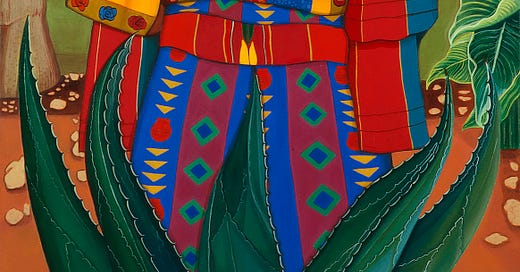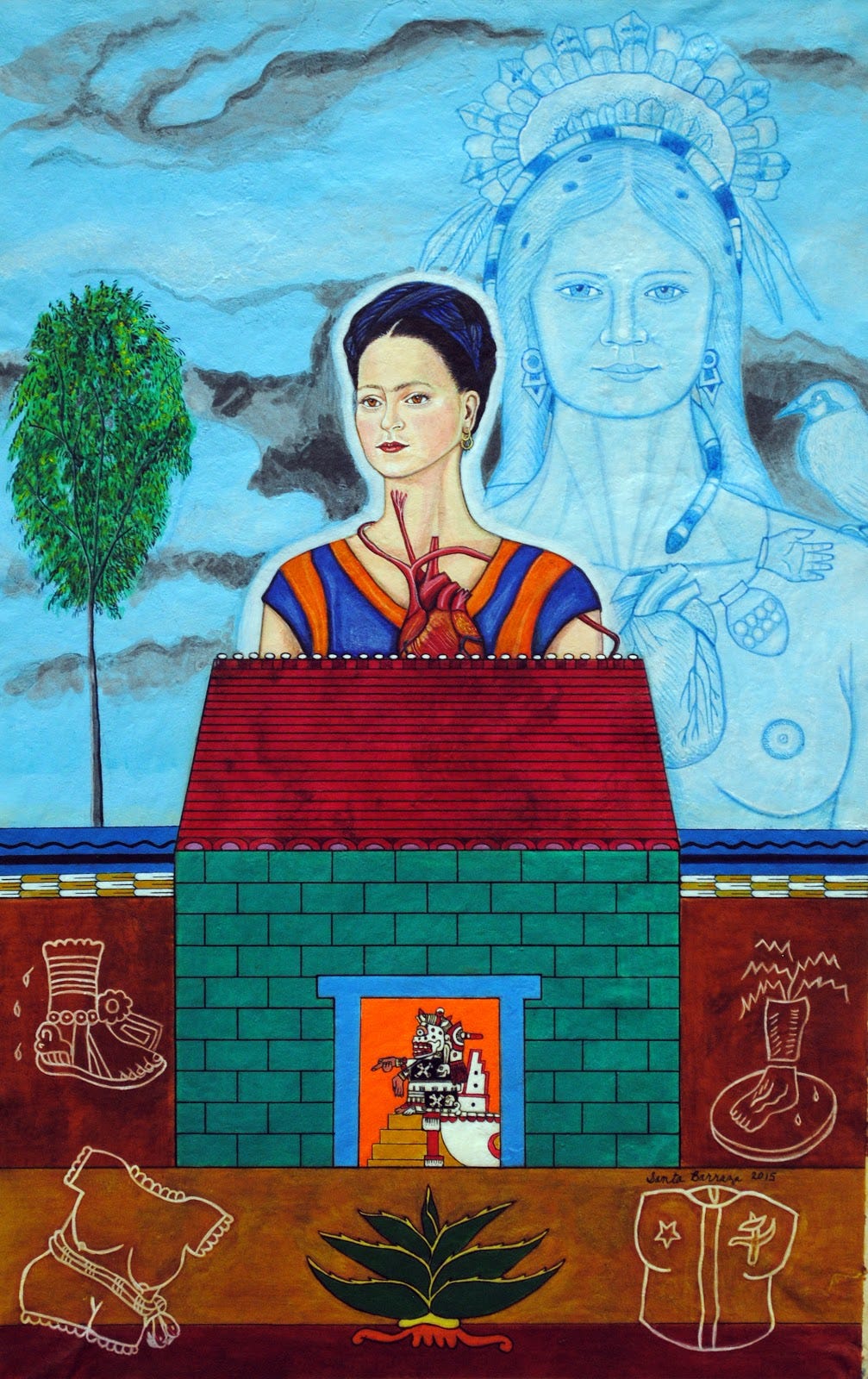Mexican American Artist Santa Barraza
Mexican American Artist Santa Barraza
Santa Barraza, a South Texas Kingsville native, experienced her first national breakthrough in 1990 when her painting was selected for the Wright Gallery “CARA” exhibit at the University of California Los Angeles. The Chicano Art: Resistance and Affirmation, known as CARA, traveled to ten American cities and included Washington, DC’s Smithsonian National Museum of American Art.
Santa Barraza. Nepantla. 1995. Oil on canvas.
At the time of her selection for the CARA exhibit, Barraza taught art at Texas College of Arts and Industries [Texas A&I], a predominantly Latino campus in South Texas. [In 1993 Texas A&I changed its name to Texas A&M-Kingsville]. Barraza taught for 35 years on that campus where she first discovered her passion for art. Her story is inspirational and worthy of study. Here is how her art career began.
Seventeen year old Barraza enrolled at Texas A&I in her hometown of Kingsville in 1969. She arrived during a year of unprecedented political unrest across America’s colleges. The unrest, largely associated with the anti-Vietnam war movement, resulted in mass demonstrations and protests on college campuses and in urban public spaces.
Mexican American students at the Texas A&I campus were likewise politicized by anti-war activists in the late 1960s. Even greater political influences came from labor organizers involved in Cesar Chavez’ farm workers movement in South Texas and the rise of “El Movimiento” [Chicano political movement] associated with the Mexican American Youth Organizations [MAYO] and later La Raza Unida Party.
Santa Barraza. La Malinche.
Barraza had intended to study mathematics, but an art course in her second semester convinced her to major in art. At Texas A&I, Barraza met a score of Mexican American artists who identified with “El Movimiento” and believed that through their art they could help “la causa.” Barraza’s artist statement for the CARA exhibit included thoughts about growing up. She wrote: “Coming of age in a border-town community in Texas during the 1960s and early 1970s helped shape my art.”
Baraza wrote in her autobiographical essay that her years at the Kingsville campus were exciting, “with the Chicano movement, the women’s movement, peace movement protests against the Vietnam War, and other movements for social, political, and economic change.” Chicano artists Amado Pena, Cesar Martinez, and Jose Rivera were among the Kingsville students involved in “El Movimiento” in the mid 1960s. They remained in contact with students like Barraza and Carmen Lomas Garaza who attended A&I in the late 1960s and early 1970s.
With the intent of pursuing a bachelor of fine arts degree, Barraza transferred to the University of Texas at Austin. In the early 1970s she was one of few Chicana students in UT Austin’s art department. The art department faculty, however, included Jacinto Quirarte, one of the premier Mexican American art professors in the United States. She took classes in the newly minted Mexican American Studies program, including a border studies class with Dr. Jorge Bustamante, one of America's leading Chicano sociologists.
Santa Barraza. "Frida con Tezcoatlipoca y Coyolxauhqui
In Austin she also re-acquainted with Carmen Lomas Garza, Cesar Martinez, and Amado Pena. Barraza gave careful thought to her artistic approach and philosophy. She wrote: “I am interested in borders as regions of appropriation. I appropriated pre-Columbian symbols and myths in historical and contemporary symbols as mechanisms for resistance to oppression and assimilation.” [CARA Catalogue]
Barraza currently lives in a community once populated by the Karankawas, fierce Indian warriors who like the Apaches and Comanches, combined to hold back Spanish colonization of the region for centuries. As a tribute to her indigenous roots, she includes in many of her works the earth plants such as agave, maguey, corn, and mesquite trees which provided food, clothing, and shelter for the first people of the Americas.
Santa Barraza. "La Mano Poderosa de Coyolxauhqui," 1995,
Barraza’s ancestral roots also include the Spanish-Mexican mestizos who arrived on the border in the 1750s. As a Chicano feminist and cultural interpretor, many of her works included in her book, Santa Barraza: Artist of The Borderlands, draw upon historical figures such as La Virgin Guadalupe, La Malinche, and La Llorona. Her more modern visual presentations include labor leader Emma Tennayuca, singers Selena and Lydia Mendoza, curandero [faith healer] Don Pedro Jaramillo, and the Soldaderas of the Mexican Revolution.
Barraza recently retired and remains committed to her art. She continues to exhibit and enjoys public presentations about her art and borderland subjects. She has also opened an art Gallery in the downtown center of Kingsville to show Latino art and to continue her commitment to promoting images of cultural interpretations and affirmation.






